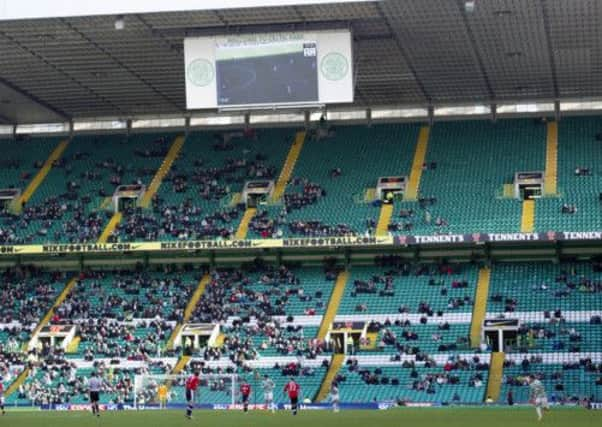The Rangers-free SPL has survived, not thrived


And, when set against the challenging economic backdrop, the manner in which support has held up for most Scottish Premier League teams speaks of a robustness that a doom-mongering chorus last summer discounted.
Of course, the demise of the old Rangers has led to a huge drop in the overall total for top-flight ticket sales, and the picture is mixed. On the latter front, though, each campaign always is, because individual factors will impact on the number of seats any club will be able to sell. But the fact that half of the 12 top-flight clubs have posted an increase in their year-on-year figures – Dundee and Ross County inevitably doing so as the league’s newcomers – is pretty remarkable. To do so without the Rangers fan base that on average has accounted for almost 5 per cent of SPL clubs’ home gates previously, points to more supporters having backed their teams. Certainly that is true for Hibernian and Aberdeen. Derbies, meanwhile, have seen slight upswings for Dundee United and Inverness Caledonian Thistle.
Advertisement
Hide AdAdvertisement
Hide AdIn some cases, more local support could not offset the reduction created by the loss of potentially two visits from Rangers. Kilmarnock, with a 20 per cent drop, Motherwell and Celtic have been the biggest losers in terms of the projections this newspaper made last summer. In the case of the champions, the loss of their major rival has meant 70,000 fewer seats sold, the biggest single reduction in sales. Actual attendances we can only speculate at, with it believed around 10,000 of the club’s 42,000 season ticket holders have regularly failed to attend this season. Celtic publish attendance figures that cover the people who pay for seats, rather than those who actually then choose to sit on them. Therein might lie a problem masked by judging the SPL numbers in isolation.
“It is a positive that, in a very difficult period, the clubs have managed to contain the attendances they have logged,” says Charles Barnett of BDO, who will soon start gathering data for the accountancy firm’s next yearly football finance directors survey. “That doesn’t give you the whole story about revenues, however. We will look at what has happened to retail, merchandise and food stall sales. If fewer people are attending, these can be impacted.
“I am not surprised by the figures overall, though, and especially the fact that clubs in the north have fared better than those in west of Scotland. The promoted club were in the north and Dundee stepping up also means a large travelling support in that area. That support won’t extend as far as such as Kilmarnock and Motherwell, however.”
Kilmarnock have experienced the biggest drop in tickets sales, 20 per cent down from a year ago. Manager Kenny Shiels talks of that figure – the product of numbers going from just under 100,000 to 80,000 across 17 home games – as being “doctored” since it doesn’t take account of a particular visit by a Glasgow club last season. Nearly 16,000 were there to witness Celtic winning the league last year – the equivalent of nearly four average league attendances at Rugby Park.
“If you are looking for other reasons, last year we had the upturn in the run-in to the semi-final and final of the League Cup, and after,” Shiels says. “It isn’t a case that we are suffering because of the product, or that people aren’t supporting the club. Our season ticket sales are the highest in a number of years.”
With their season ticket sales believed to be 5 per cent up on last year in the wake of the League Cup win, Kilmarnock chairman Michael Johnston stated the club would need to put 1,000 on their base figure of around 4,000 to compensate for the loss of Rangers gates.
Meanwhile, Motherwell, 11 per cent down despite an outstanding league campaign, also admit to feeling the pinch without visits from Rangers, despite hosting Celtic three times this season. Yet, press and media manager Alan Burrows points out that the club’s home support is “slightly” up, with game scheduling a negative driver in overall figures. “We have had a tough season when it comes to live TV picks and moving matches due to European commitments,” he says. “We have only had seven home Saturday 3pm kick-offs, and just two in the whole of 2013 so far – we had 12 last season, almost a 60 per cent reduction in that sense. Non-Saturday 3pm [games] have an adverse effect on away crowds.”
Yet, the fact that a television deal remains in place on much the same terms as existed when the Ibrox club were in the upper tier is crucial. The Scottish top flight can cope with a temporary absence of the Rangers brand. It could not do so and remain of similar standing if the loss were permanent.
Advertisement
Hide AdAdvertisement
Hide AdWithout the one million ticket sales that a Rangers team in the SPL could generate, the status of our highest league has already been diminished. In 2011-12, the average attendance for a top-flight match in this country was just under 14,000. That placed Scotland ahead of nations such as Brazil, Turkey, Belgium, Ukraine and Portugal, according to a recent World Soccer survey. This year that figure will be shy of 10,000, dropping Scotland below these five countries. There is a difference between comfortably surviving and thriving.